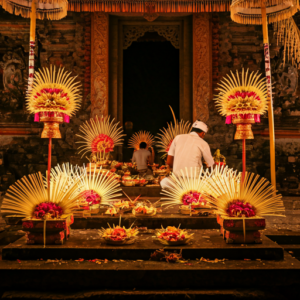
Bali, known for its stunning beaches and lush landscapes, also harbors a hidden world beneath its surface – a labyrinth of caves shrouded in mystery and intrigue. From ancient burial sites to sacred temples and subterranean rivers, Bali’s caves offer adventurers a chance to delve into the island’s rich history and unearth secrets that lie hidden in the darkness. In this exploration, we descend into the depths of Bali’s caves, uncovering the stories, legends, and mysteries that await those who dare to venture underground.
The Rich Cultural and Historical Significance of Bali’s Caves
Bali’s caves hold a special significance in the island’s cultural and historical tapestry, serving as sacred sites, burial chambers, and places of worship for centuries. From the prehistoric era to the present day, caves have played a central role in Balinese religious rituals, mythologies, and traditions, shaping the island’s cultural identity and spiritual landscape.
One of the most iconic caves in Bali is Goa Gajah, or the Elephant Cave, located near the town of Ubud. Dating back to the 9th century, Goa Gajah features a cavernous entrance adorned with intricate carvings of demons, gods, and mythological creatures, offering a glimpse into the island’s ancient Hindu-Buddhist heritage. Inside the cave, visitors can explore a sacred bathing pool and meditation chambers, evoking a sense of reverence and awe for the centuries-old rituals that once took place within its hallowed walls.
Another notable cave site in Bali is Goa Lawah, or the Bat Cave, situated along the island’s eastern coast. Named for the thousands of bats that inhabit its cavernous depths, Goa Lawah is revered as a sacred site and place of pilgrimage for Balinese Hindus. According to legend, the cave is said to be connected to Mount Agung, the island’s highest peak, and serves as a gateway to the underworld. Visitors can witness colorful ceremonies and offerings at the cave’s entrance, where devotees come to pay homage to the gods and seek blessings for health and prosperity.
Exploring Bali’s Hidden Gems
Beyond the well-known cave sites, Bali harbors a wealth of hidden gems waiting to be discovered by intrepid explorers. From secret grottos and underground rivers to ancient rock formations and hidden temples, the island’s caves offer endless opportunities for adventure and discovery.
One such hidden gem is Goa Raja, or the King’s Cave, located in the village of Sibang Kaja. Tucked away in a remote valley surrounded by lush jungle, Goa Raja is adorned with stunning rock formations and natural sculptures that evoke a sense of wonder and enchantment. Inside the cave, visitors can explore narrow passageways and hidden chambers, encountering ancient relics and sacred symbols along the way.
Another hidden treasure awaiting adventurers in Bali is Goa Gala-Gala, a labyrinthine cave system located on the island’s southeastern coast. Carved by hand over six decades by a local farmer named Mangku Byasa, Goa Gala-Gala features a network of tunnels, chambers, and staircases that lead deep into the earth. Visitors can wander through the cave’s winding passages, marveling at the intricate carvings and architectural feats that testify to the ingenuity and perseverance of its creator.
Challenges and Rewards of Cave Exploration
Exploring Bali’s caves presents a unique set of challenges and rewards, from navigating treacherous terrain and overcoming claustrophobia to encountering unexpected obstacles and hazards along the way. However, the rewards of cave exploration far outweigh the challenges, offering adventurers a chance to connect with nature, uncover hidden treasures, and forge memories that will last a lifetime.
One of the main challenges of cave exploration in Bali is the rugged and often unpredictable terrain, which can be demanding for even experienced adventurers. Caves can be dark, damp, and claustrophobic, requiring careful navigation and a keen sense of awareness to avoid getting lost or injured. Additionally, caves are home to a diverse array of flora and fauna, some of which may pose a threat to human visitors, such as venomous snakes, spiders, and bats.
Despite the challenges, the rewards of cave exploration in Bali are immeasurable, offering adventurers a chance to immerse themselves in the island’s natural beauty and uncover the secrets that lie hidden beneath its surface. From stunning rock formations and crystal-clear pools to ancient artifacts and hidden temples, Bali’s caves hold a wealth of wonders waiting to be discovered by those brave enough to venture into the darkness.
Preserving Bali’s Cave Heritage
As the popularity of cave exploration in Bali grows, so too does the importance of preserving the island’s cave heritage for future generations to enjoy. Sustainable tourism practices, such as responsible cave management, conservation initiatives, and community engagement programs, play a vital role in safeguarding Bali’s caves and ensuring that they remain accessible for years to come.
Additionally, raising awareness about the cultural and ecological significance of Bali’s caves and promoting responsible cave exploration can help minimize the impact of tourism on fragile cave ecosystems and wildlife habitats. By respecting cave regulations, following Leave No Trace principles, and supporting local conservation efforts, adventurers can help protect Bali’s caves and ensure that they remain a source of wonder and inspiration for generations to come.
Conclusion
Exploring Bali’s caves offers adventurers a chance to delve into the island’s rich history, uncover hidden treasures, and connect with the natural world in a profound and meaningful way. From ancient burial sites and sacred temples to hidden grottos and underground rivers, Bali’s caves hold a wealth of mysteries waiting to be unraveled by those brave enough to venture into the darkness.
As stewards of Bali’s cave heritage, adventurers have a responsibility to protect and preserve these sacred sites for future generations to enjoy. By embracing principles of sustainable tourism, respecting local customs and traditions, and fostering a sense of reverence for the natural world, adventurers can ensure that Bali’s caves remain a source of wonder and inspiration for years to come. In the end, the true reward of exploring Bali’s caves lies not just in the treasures unearthed or the mysteries uncovered, but in the journey itself and the connections forged with the island’s rich cultural and natural heritage.





